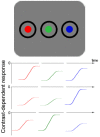Unconscious Cueing via the Superior Colliculi: Evidence from Searching for Onset and Color Targets
- PMID: 24962685
- PMCID: PMC4061783
- DOI: 10.3390/brainsci2010033
Unconscious Cueing via the Superior Colliculi: Evidence from Searching for Onset and Color Targets
Abstract
According to the bottom-up theory of attention, unconscious abrupt onsets are highly salient and capture attention via the Superior Colliculi (SC). Crucially, abrupt onsets increase the perceived contrast. In line with the SC hypothesis, unconscious abrupt-onset cues capture attention regardless of the cue color when participants search for abrupt-onset targets (Experiment 1). Also, stronger cueing effects occur for higher than lower contrast cues (Experiment 2) and for temporally, rather than nasally, presented stimuli (Experiment 3). However, in line with the known color-insensitivity of the SC, the SC pathway is shunted and unconscious abrupt-onset cues no longer capture attention when the participants have to search for color-defined targets (Experiment 4) or color-singleton targets (Experiment 5). When using color change cues instead of abrupt-onset cues, the cueing effect also vanishes (Experiment 6). Together the results support the assumption that unconscious cues can capture attention in different ways, depending on the exact task of the participants, but that one way is attentional capture via the SC. The present findings also offer a reconciliation of conflicting results in the domain of unconscious attention.
Figures













Similar articles
-
Novel tests of capture by irrelevant abrupt onsets: No evidence for a mediating role of search task difficulty during color search.Atten Percept Psychophys. 2023 Apr;85(3):667-684. doi: 10.3758/s13414-022-02623-y. Epub 2022 Dec 2. Atten Percept Psychophys. 2023. PMID: 36460927 Free PMC article.
-
The contribution of color to attention capture effects during search for onset targets.Atten Percept Psychophys. 2016 Apr;78(3):789-807. doi: 10.3758/s13414-015-1053-8. Atten Percept Psychophys. 2016. PMID: 26742497
-
Hidden from view: Statistical learning exposes latent attentional capture.Psychon Bull Rev. 2019 Oct;26(5):1633-1640. doi: 10.3758/s13423-019-01618-5. Psychon Bull Rev. 2019. PMID: 31152432
-
Testing the top-down contingent capture of attention for abrupt-onset cues: Evidence from cue-elicited N2pc.Psychophysiology. 2020 Nov;57(11):e13655. doi: 10.1111/psyp.13655. Epub 2020 Aug 13. Psychophysiology. 2020. PMID: 32790903
-
Attentional dwelling and capture by color singletons.Atten Percept Psychophys. 2020 Aug;82(6):3048-3064. doi: 10.3758/s13414-020-02054-7. Atten Percept Psychophys. 2020. PMID: 32483661
Cited by
-
Inhibition of return is no hallmark of exogenous capture by unconscious cues.Front Hum Neurosci. 2012 Feb 24;6:30. doi: 10.3389/fnhum.2012.00030. eCollection 2012. Front Hum Neurosci. 2012. PMID: 22375115 Free PMC article.
-
The Nature of Unconscious Attention to Subliminal Cues.Vision (Basel). 2019 Aug 1;3(3):38. doi: 10.3390/vision3030038. Vision (Basel). 2019. PMID: 31735839 Free PMC article. Review.
-
Cue-target contingencies modulate voluntary orienting of spatial attention: dissociable effects for speed and accuracy.Psychol Res. 2018 Mar;82(2):272-283. doi: 10.1007/s00426-016-0818-6. Epub 2016 Oct 21. Psychol Res. 2018. PMID: 27770287
References
-
- Neisser U. Cognitive Psychology. Appleton-Century-Crofts; New York, NY, USA: 1967.
-
- Wundt W. Grundriß der Psychologie (Compendium of Psychology) Engelmann; Leipzig, Germany: 1896.
LinkOut - more resources
Full Text Sources

